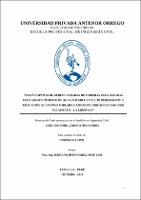Mostrar el registro sencillo del ítem
Diseño óptimo de redes cerradas de tuberías presurizadas para abastecimiento de agua potable en flujo permanente y aplicación al Centro Poblado Campanita ubicado en San José Pacasmayo – La Libertad
| dc.contributor.advisor | Serrano Hernández, José Luis | |
| dc.contributor.author | Zapata Negreiros, Luis Armando | |
| dc.creator | Zapata Negreiros, Luis Armando | |
| dc.date.accessioned | 2015-03-06T20:33:28Z | |
| dc.date.available | 2015-03-06T20:33:28Z | |
| dc.date.issued | 2014 | |
| dc.identifier.uri | https://hdl.handle.net/20.500.12759/618 | |
| dc.description.abstract | El objetivo de la presente tesis es diseñar en forma óptima redes cerradas de tuberías presurizadas para abastecimiento de agua potable, para lo cual se plantea una metodología basadas en algoritmos ingeniosos, lógicos y relativamente sencillos. La aplicación con la finalidad de explicar referida metodología en una forma didáctica es al centro poblado campanita ubicado en el distrito de San José, provincia Pacasmayo, departamento La Libertad. Se realizó una revisión del fundamento hidráulico aplicado a redes cerradas de tuberías presurizadas siendo los principios de conservación de masa y energía los que gobiernan el cálculo hidráulico. Con ayuda del Ms Excel, se comparó los diversos métodos de cálculo hidráulico verificándose su convergencia y estabilidad. Se seleccionó al método de la Teoría Lineal como el motor de cálculo hidráulico para la metodología de optimización que se propone por ser su relativa sencillez. La normatividad actual (OS. 050 REDES DE DISTRIBUCIÓN DE AGUA PARA CONSUMO HUMANO) no contempla la optimización en el diseño de tuberías presurizadas que conforman sistemas de distribución de agua potable. Con la metodología propuesta se pretende complementarla. La metodología para optimización contempla priorizar tuberías teniendo en cuenta el número de Reynolds, aumentando el diámetro de tubería por el inmediato superior comercial de opción por iteración que tenga mayor beneficio/costo hasta alcanzar carga de presión mínima (10 m H2O) al menor costo, permitiendo también dar seguimiento al análisis de cálculo hidráulico desde un punto de vista físico identificando las tuberías principales, como se demuestra en la aplicación donde las tuberías principales son P1, P2, P7 y P8, lo cual tiene correlación lógica con la topografía del terreno, es decir, se necesita de tuberías con mayor diámetro para que la línea de carga dinámica se mantenga en niveles que garanticen una carga de presión adecuada en este sector; lo cual se obtiene reduciendo las pérdidas de carga por fricción aumentando el diámetro en tuberías. | es_PE |
| dc.description.abstract | The objective of this thesis is to design optimally closed pressurized pipe networks for drinking water, for which a methodology based on ingenious, logical and relatively simple algorithms is proposed. The application in order to explain Said methodology in a didactic way is to populated bell located in the district of San José, Pacasmayo province, La Libertad department center. A review of the hydraulic foundation applied to closed pressurized pipe networks being the principles of conservation of mass and energy which govern the hydraulic calculation was performed. With the help of Ms Excel, various methods of hydraulic calculations verifying their convergence and stability compared. Was selected the method of Linear Theory as hydraulic calculation engine for optimization methodology is proposed to be its relative simplicity. Current regulations (OS. 050 REDES DE DISTRIBUCIÓN DE AGUA PARA CONSUMO HUMANO) does not provide optimization in the design of pressurized piping systems that make water distribution. With the proposed methodology is intended to complement it. The methodology provides for optimization taking into account priority pipe Reynolds number, increasing the diameter of the pipe immediately above iteration commercial option that has more benefit/cost to reach minimum pressure load (10 m H2O) at the lowest cost, also allowing to track analysis of hydraulic calculation from a physical standpoint identifying the main pipes, as demonstrated in the application where mains are P1, P2, P7 and P8, which is logical correlation with the topography, that is, it takes larger diameter pipe for the dynamic load line is maintained at levels that ensure adequate pressure load in this area; which is obtained by reducing the frictional losses in increasing the pipe diameter. | en_US |
| dc.description.uri | Tesis | es_PE |
| dc.format | application/pdf | es_PE |
| dc.language.iso | spa | es_PE |
| dc.publisher | Universidad Privada Antenor Orrego - UPAO | es_PE |
| dc.rights | info:eu-repo/semantics/openAccess | es_PE |
| dc.source | Universidad Privada Antenor Orrego | es_PE |
| dc.source | Repositorio Institucional - UPAO | es_PE |
| dc.subject | Redes cerradas de tubería | es_PE |
| dc.subject | Abastecimiento de agua | es_PE |
| dc.subject | Centro Poblado Campanita | es_PE |
| dc.title | Diseño óptimo de redes cerradas de tuberías presurizadas para abastecimiento de agua potable en flujo permanente y aplicación al Centro Poblado Campanita ubicado en San José Pacasmayo – La Libertad | es_PE |
| dc.type | info:eu-repo/semantics/bachelorThesis | es_PE |
| thesis.degree.level | Título Profesional | es_PE |
| thesis.degree.grantor | Universidad Privada Antenor Orrego. Facultad de Ingeniería | es_PE |
| thesis.degree.name | Ingeniero Civil | es_PE |
| thesis.degree.discipline | Ingeniería Civil | es_PE |
Ficheros en el ítem
Este ítem aparece en la(s) siguiente(s) colección(es)
-
Ingeniería Civil [1085]

